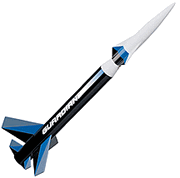| Construction Rating: | starstarstarstar_borderstar_border |
| Flight Rating: | starstarstarstarstar |
| Overall Rating: | starstarstarstarstar_border |
| Diameter: | 1.33 inches |
| Length: | 19.13 inches |
| Manufacturer: | Estes  |
| Style: | Sport |
 Brief:
Brief:
This is an Estes 2003 Level 2 kit. It is very similar to the Estes Polaris but with different fin alignment. The kit uses Parachute recovery.
Construction:
The kit contains:
- A main body tube
- Upper body tube
- Adapter
- Launch lug
- Nose cone
- Motor mount
- Die cut fin sheets
- Shock cord
- Assembled 12 inch parachute and decals.
PROS:
- Typical easy-to-follow Estes instructions (excellent diagrams & text).
CONS:
- Lots of fins to line up.
- The cutout to mark the fin lines for the upper body tube is too short to wrap around the tube correctly (so if you use the cutout, your fins will not line up properly--use the Estes marking guide instead!)
- Consider replacing the shock cord with one at least twice as long.
Construction starts with the motor mount (like most Estes kits). The small fins that edge up to the bottom of the main BT are glued on next. Give yourself plenty of time for those to dry before tackling the step of gluing the larger fins so that all fins line up properly. While those are drying, move on to assembling the nose cone, upper BT, adapter & fins. Instructions suggest rounding the edges of the fins on the upper BT after gluing them on. Do it before you glue instead! It is much easier & there is less risk of damage to the fins.
Attaching the shock cord & parachute are the final steps before painting (although I prefer to do these steps in reverse order).
Finishing:
PROS:
- Aggressive looking rocket no matter what paint scheme is used.
CONS:
- Large spiral in main BT. I would consider going the extra steps to fill & sand for a more attractive, smooth finish.
- Beginners should not expect this rocket to look like the packaging - the decals are much smaller & more simple than the multicolor design suggests.
I considered an attempt at emulating the paint job on the packaging but I am still coming up to speed as an enthusiast who has been out of the loop for almost 20 years. Instead I went with a simple white Nose Cone / black BT scheme. The instructions don't mention this but I recommend sanding the main BT with some 400 grit paper before priming. Also, if you paint this a light color on the Nose Cone section, use a white primer so you get a consistent shade. I finally applied the self-adhesive decals (which I trimmed slightly on one end so they would butt up evenly against the edge of the BT) & finished with a clearcoat.
Construction Rating: 3 out of 5
Flight:
PROS:
- Easy preparation.
- Excellent flights on both a B6-4 & C6-5.
- 12" chute allows for recovery that should be close to launch site even on a windy day.
CONS:
- With any Estes rocket, keep an eye on the shock cord near the mount for damage after flight.
Recommended motors for this rocket are the A8-3 B4-4 B6-4 (first flight) C6-5.
Three or four pieces of recovery wadding along with the chute fit very easily and quickly inside the BT. Make sure that top fins are aligned with the main body fins before launch. With the large BT, you do not have to fold & wind up the parachute tightly to get it to fit inside.
I flew the rocket twice. After reading reviews of the Estes Polaris, I had the impression that an A8-3 wouldn't be enough to push a rocket with such a large diameter main BT & nine fins.
First flight was on a B6-4. Very straight trajectory even into a slight wind. Picture perfect & excellent height.
Second flight was with a C6-5. Again it had excellent trajectory with considerably greater height and speed.
Recovery:
PROS:
- Rocket comes down nice on the provided chute.
On both flights the ejection charge fired at apogee and the parachute opened flawlessly. The 12" chute allows for safe but rapid descent close to the launch site even on windy days (minimal drift).
Consider replacing the plastic chute with a mylar one. Make sure to use 4 pieces of wadding or you will quickly shorten the lifespan of your shockcord as well.
Flight Rating: 5 out of 5
Summary:
OVERALL PROS:
- Great looking rocket even when standing still.
- High, straight flights on B & C engines.
- Perfect recovery with a 12" chute.
OVERALL CONS:
- Lots of fins that need to be aligned together.
- Minimal decals compared to the picture on the packaging.
I had high hopes for this design when building it and I was not disappointed. The Guardian is going to be one of the highlights in my personal fleet as long as it continues its high flights and great recoveries.
Overall Rating: 4 out of 5
Other Reviews
- Estes Guardian By Alex Laraway (July 6, 2010)
Brief: Multi-finned scale model. Parachute recovery, level 2 build, balsa fins, plastic nose cones, transitions. Construction: Parts List: BT 55 main body tube BTU 50 (ish) upper body tube Upper fins Large Lower fins Small lower fins Two centering rings Blue motor mount tube Engine hook Transition Nose cone Decals Engine Block ...
 |
 |
Flights
 |
 |
L.A. (May 11, 2003)
J.W. (July 20, 2003)
J.H. (May 20, 2004)
Sponsored Ads
 |
 |












R.D. (April 23, 2003)